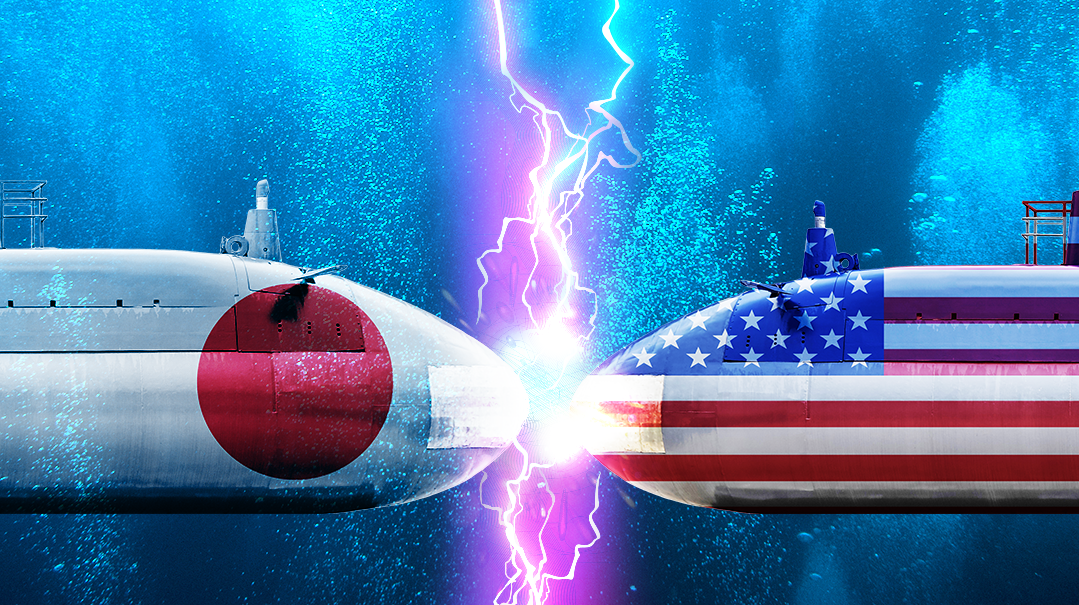Secret Weapon

This was not simply a submarine. This was an underwater aircraft carrier!

Sea Monster
USS Segundo, Sea of Okhotsk, August 28, 1945
The USS Segundo was an American submarine that was on her final war patrol in the Sea of Okhotsk, sailing south toward Tokyo Bay. Just three weeks earlier, on August 6 and 9 respectively, America had dropped two atom bombs over the Japanese cities of Hiroshima and Nagasaki, forcing Emperor Hirohito to finally admit defeat. On August 15, the emperor had announced Japan’s surrender. But Japanese naval vessels were still out there, and the Segundo’s mission was to round them up and bring them back home.
Just before midnight, an unidentified object appeared on the Segundo’s sonar. The sub’s captain, Lieutenant S. Johnson, and his crew, quickly realized that this was a Japanese submarine. What they didn’t realize was that this was the largest submarine in the world, the likes of which they had never seen before. The Americans had discovered Japan’s secret weapon.
After a four-hour chase, the Americans managed to convince the Japanese sub to rise to the surface. Nothing prepared Captain Johnson for the unbelievable sight that met his eyes when he went up on deck. Less than 500 meters (1,640 feet) away, a monstrous submarine broke through the surface; he had never seen anything like it in his life. The I-401 submarine was twice the size of the Segundo, and had more than double the number of crewmembers.
A figure appeared on the deck of the enemy sub. It was head navigator Officer Muneo Bando, who had come to negotiate the terms of surrender. In his broken English, he told Johnson that things wouldn’t be easy for the American crew. The commander of the Japanese submarine, Captain Ariizumi, would rather die than admit defeat. It turned out that Ariizumi had been sleeping when the Japanese emperor had broadcast his surrender announcement to the nation, and he refused to come to terms with the possibility of surrender. There were also a number of Japanese crew members who refused to reconcile with the idea. They threatened to take control of the submarine and to launch raids on the Americans, or to carry out mass hara-kiri (suicide).
A small number of American naval officers boarded the Japanese monster to take control of the vessel. They were given a bottle of Suntory whiskey by the crew in a gesture of surrender.
As the American officers walked through the galleys, the Japanese crewmembers looked at them with daggers in their eyes. Thankfully, no one made any trouble and soon the black flag of surrender was flying on the mast. The Japanese submarine followed the Segundo into Tokyo Bay, where it officially surrendered.
Senior American naval officers could now explore the I-401 properly. They were shocked and awed at what they found. Their shock was all the greater when they heard that the Japanese had not one, but four such submarines.
But the biggest shock was what they found inside the vessel. Right there in the belly of the sub, the Americans discovered a capsule containing three combat aircraft! The aircrafts’ wings and tails were folded up to allow them to fit in the tight space. The Americans had never seen such a thing before.
Now, the true purpose of the I-401 was obvious. This was not simply a submarine. This was an underwater aircraft carrier!
Pearl Harbor 2.0
The discovery of the monster sub and its strange, folded aircraft came along with the discovery of a secret Japanese plan to bring America to its knees. If the Japanese had been successful, they would have almost certainly won the war.
The plan was the brainchild of Admiral Isoroku Yamamoto, the commander in chief of the Japanese Combined Fleet. He was also the architect of the Pearl Harbor attack. But Pearl Harbor wasn’t enough for Yamamoto. He wanted to attack the major cities along the east and west coasts of America, as well as destroy the Panama Canal so that it would be impossible for America to transport her soldiers to the Pacific. (Read more about the Panama Canal in the sidebar below.) The only way to do that was to build a submarine and an airplane that did not yet exist.
The Panama Canal
In the early 1900s, the United States government realized that if they were to take over from the British Empire as the world’s most important superpower, they would need to control the world’s shipping routes. At that time, a ship sailing from the Pacific Ocean to the Atlantic Ocean (or vice versa) would have to travel all the way around South America, adding weeks to the voyage. What if ships could take a shortcut across the continent?
In 1903, the US signed a treaty with Panama that gave the US control over the area that was the narrowest part of Central America — the perfect place to build a canal. In 1914, the Panama Canal was open for business; the two largest oceans were finally connected. International trade was booming since the Far East and Europe were suddenly closer than ever. And the US controlled it all! When World War I ended in 1918, the British Empire was no longer the mighty empire it had been for hundreds of years, and America was ready to take over.
Toward the end of World War II, it was clear that the fighting in Europe was coming to a close. But not all American soldiers would be going home. America was still fighting the Japanese in the Pacific arena. The US had to ship troops from Europe to the Pacific, making the Panama Canal a busy place indeed. And that made the Panama Canal a very enticing target for the Japanese. Destroying the canal would be killing two birds with one stone: It would end America’s great power and leave her soldiers stranded.
Surprise Storm
Admiral Yamamoto had very specific requirements for this new submarine and bomber planes.
The submarine would have to be able to sail from Japan to any spot on the globe without refueling. It would have to be stealthy but also large enough to carry at least two fighter planes.
The bomber planes would have to be folded up to fit inside the sub’s capsule. When the “attack” signal was given, the crew would have to put the planes together in just 45 minutes. The I-400-class submarines (which included the I-401) had a catapult launcher on its upper deck that would catapult the bomber planes into the air. As soon as the planes were off, the sub would slip back under the water. To the enemy, it would seem as though the Japanese planes had appeared out of thin air. Once the planes had completed their mission, they would land on the water near the resurfaced sub. A huge crane on the sub’s deck would lift the planes back onto the vessel.
The plan was ambitious and audacious, but the Japanese managed it. They developed the largest submarine in the world and a completely new type of aircraft they called Seiran, Japanese for “clear sky storm.” A fitting name indeed. No enemy would see that storm coming, not even from a mile away.
A Japanese engineer had worked on the Panama Canal when it was being constructed. He informed the Japanese navy of all the canal’s weak spots. It would be almost too simple for the Seirans to destroy the canal.
The Japanese had thought of everything. Now they just needed things to fall into place.
And fall they did — just not in the way the Japanese expected. Admiral Yamamoto was killed in an air ambush, and things slowly startled to unravel. The original proposal for 18 monster submarines was cut to just four. Materials were scarce, so construction of the subs and planes was delayed. By the time they were ready, America had managed to transport most of her troops through the Panama Canal, so that was no longer a major target. Before the I-400s and Seirans could do any serious damage, two atom bombs fell on Japan and put an end to their grandiose plans. Japan’s secret weapon had become irrelevant.
Deep under the waters of Pearl Harbor, along with the remains of the officers and ships that went down in the Pearl Harbor attacks, lie the wrecks of four I-400-class submarines. The US torpedoed the subs to prevent the Russians from discovering their secrets. But rumor has it that there was a fifth Japanese submarine that refused to surrender. Is it still out there somewhere?
(Originally featured in Mishpacha Jr., Issue 901)
Oops! We could not locate your form.






